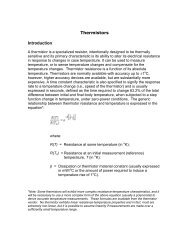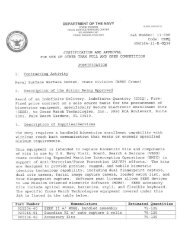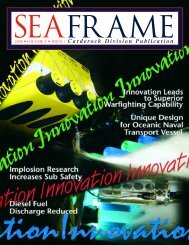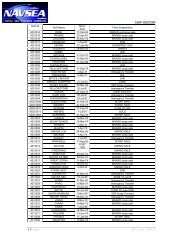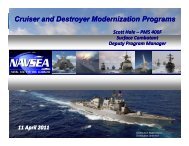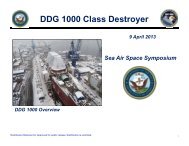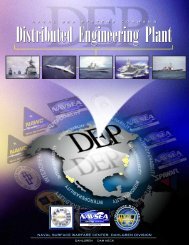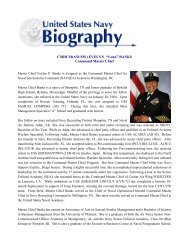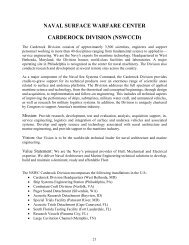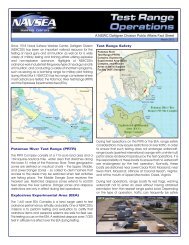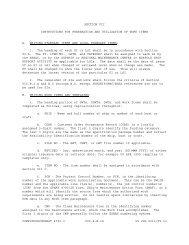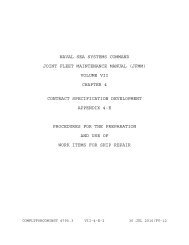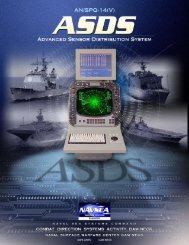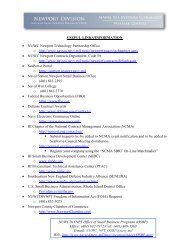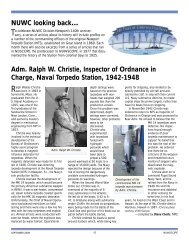Volume 6, Issue 1 - Naval Sea Systems Command - The US Navy
Volume 6, Issue 1 - Naval Sea Systems Command - The US Navy
Volume 6, Issue 1 - Naval Sea Systems Command - The US Navy
You also want an ePaper? Increase the reach of your titles
YUMPU automatically turns print PDFs into web optimized ePapers that Google loves.
By<br />
William<br />
Palmer<br />
Some teams of the <strong>Naval</strong><br />
Surface Warfare Center, Carderock<br />
Division, spend almost all of their<br />
time increasing the efficiency of a<br />
process. In the Division’s Advanced<br />
Machinery <strong>Systems</strong> Integration branch<br />
in Philadelphia, 85 to 90 percent of<br />
the branch personnel work to steadily<br />
improve and enhance system design<br />
decisions. One part of these decisions<br />
involves component and system reliability. When the group<br />
engages in advanced machinery design, modeling the reliability<br />
factor of those designs helps save time and money, and affects<br />
the acquisition and shipbuilding processes.<br />
Reliability modeling is intimately tied to other<br />
modeling and simulation processes, computer programs<br />
and environments to extract the most effective system<br />
design possible from available configurations. Tools such<br />
as an energy calculator, cross-performance modeling, ship<br />
efficiency and thermal modeling can be brought into play to<br />
develop the entire set of feasible system designs. Different<br />
design alternatives can be explored by subjecting the ship<br />
design to scrutiny by the various efficiency tools. Not<br />
only can design features be analyzed, but they can also be<br />
changed from within the domain of the modeling tools to<br />
determine the best design that meets all of the key design<br />
parameters. In the long term, the most important questions<br />
to answer are those concerning ship life cycle cost,<br />
reliability and performance.<br />
When you ask how much money can be saved<br />
using reliability modeling, you’re going to get a myriad of<br />
responses, and it varies study by study. Factors such as fuel<br />
Core equities<br />
RELIABILITY<br />
MODELING<br />
Combining Several Prediction<br />
Models to Sharpen Design Acumen<br />
SEAFRAME<br />
cost can even vary with time when using an energy calculator<br />
because as fuel costs fluctuate, efficiency and money saved<br />
by using a particular ship design or propulsion system can<br />
vary. Many times, deriving the cheapest design solution is not<br />
the most desirable design goal. “You may have lots of factors<br />
people want to trade off,” says Tim Klingensmith, head of<br />
the Philadelphia branch. “<strong>The</strong>y might want something that<br />
gives them the greatest range of operation for a given amount<br />
of money, coupled with the best reliability possible in that<br />
mix of range and cost. It’s a multi-parameter decision you’re<br />
trying to make, so it can be difficult to pinpoint.”<br />
A reliability model can take anywhere from a few<br />
seconds to a few days to execute. <strong>The</strong> length of time depends<br />
on the complexity of the model. For instance, if an entire<br />
ship design is being modeled, the process could execute,<br />
but varying parameters with each execution, as many as one<br />
thousand iterations are processed, each iteration taking about<br />
20 minutes to complete.<br />
Currently, the group is performing a total ownership<br />
cost study for the <strong>Naval</strong> <strong>Sea</strong> <strong>Systems</strong> <strong>Command</strong>’s Future<br />
Concepts and Surface Ship Design Group (SEA 05D) for the<br />
Littoral Combat Ship program. <strong>The</strong>y are helping to evaluate<br />
the designs of both the Lockheed Martin and the General<br />
Dynamics designs, looking for changes in system design<br />
that may help to reduce costs. Some actions being studied<br />
are reducing the frequency of maintenance or reducing the<br />
number of components in a system. “Eventually, we’ll be<br />
feeding reliability numbers and operating hour numbers to<br />
other NAVSEA components,” says Dave Woodward, senior<br />
technical lead for the reliability modeling effort. “<strong>The</strong>y will<br />
RELIABILITy MODELING (Continued on page 18)<br />
17



